display TOYOTA RAV4 PHEV 2021 User Guide
[x] Cancel search | Manufacturer: TOYOTA, Model Year: 2021, Model line: RAV4 PHEV, Model: TOYOTA RAV4 PHEV 2021Pages: 666, PDF Size: 161.28 MB
Page 90 of 666
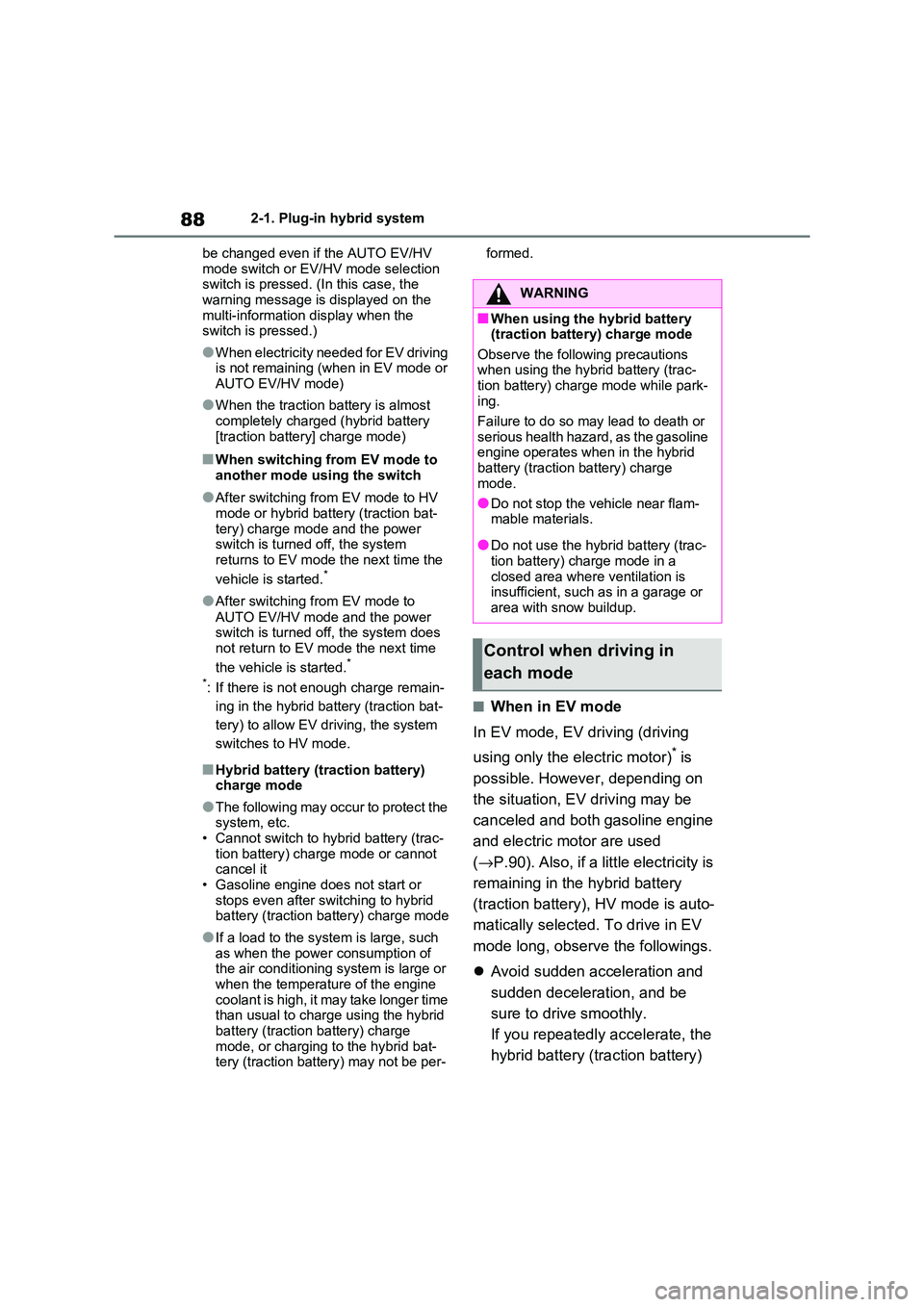
882-1. Plug-in hybrid system
be changed even if the AUTO EV/HV
mode switch or EV/HV mode selection switch is pressed. ( In this case, the
warning message is displayed on the
multi-information display when the switch is pressed.)
●When electricity needed for EV driving is not remaining (when in EV mode or
AUTO EV/HV mode)
●When the traction battery is almost
completely charged (hybrid battery
[traction battery] charge mode)
■When switching from EV mode to another mode using the switch
●After switching from EV mode to HV
mode or hybrid battery (traction bat - tery) charge mode and the power
switch is turned off, the system
returns to EV mode the next time the
vehicle is started.*
●After switching from EV mode to
AUTO EV/HV mode and the power switch is turned o ff, the system does
not return to EV mode the next time
the vehicle is started.*
*: If there is not enough charge remain-
ing in the hybrid battery (traction bat -
tery) to allow EV dr iving, the system
switches to HV mode.
■Hybrid battery (tr action battery) charge mode
●The following may occur to protect the system, etc.
• Cannot switch to hybrid battery (trac -
tion battery) char ge mode or cannot cancel it
• Gasoline engine does not start or
stops even after s witching to hybrid battery (traction battery) charge mode
●If a load to the syst em is large, such
as when the power consumption of the air conditioning system is large or
when the temperatur e of the engine
coolant is high, it may take longer time than usual to charge using the hybrid
battery (traction battery) charge
mode, or charging to the hybrid bat - tery (traction battery) may not be per -
formed.
■When in EV mode
In EV mode, EV driving (driving
using only the electric motor)* is
possible. Howeve r, depending on
the situation, EV driving may be
canceled and both gasoline engine
and electric motor are used
( →P.90). Also, if a little electricity is
remaining in the hybrid battery
(traction battery) , HV mode is auto-
matically selected. To drive in EV
mode long, observe the followings.
Avoid sudden acceleration and
sudden deceleration, and be
sure to drive smoothly.
If you repeatedly accelerate, the
hybrid battery (traction battery)
WARNING
■When using the hybrid battery (traction battery ) charge mode
Observe the following precautions
when using the hybrid battery (trac - tion battery) char ge mode while park-
ing.
Failure to do so may lead to death or
serious health hazard, as the gasoline engine operates when in the hybrid
battery (traction battery) charge
mode.
●Do not stop the vehicle near flam -
mable materials.
●Do not use the hybrid battery (trac -
tion battery) charge mode in a
closed area where ventilation is insufficient, such a s in a garage or
area with snow buildup.
Control when driving in
each mode
Page 91 of 666
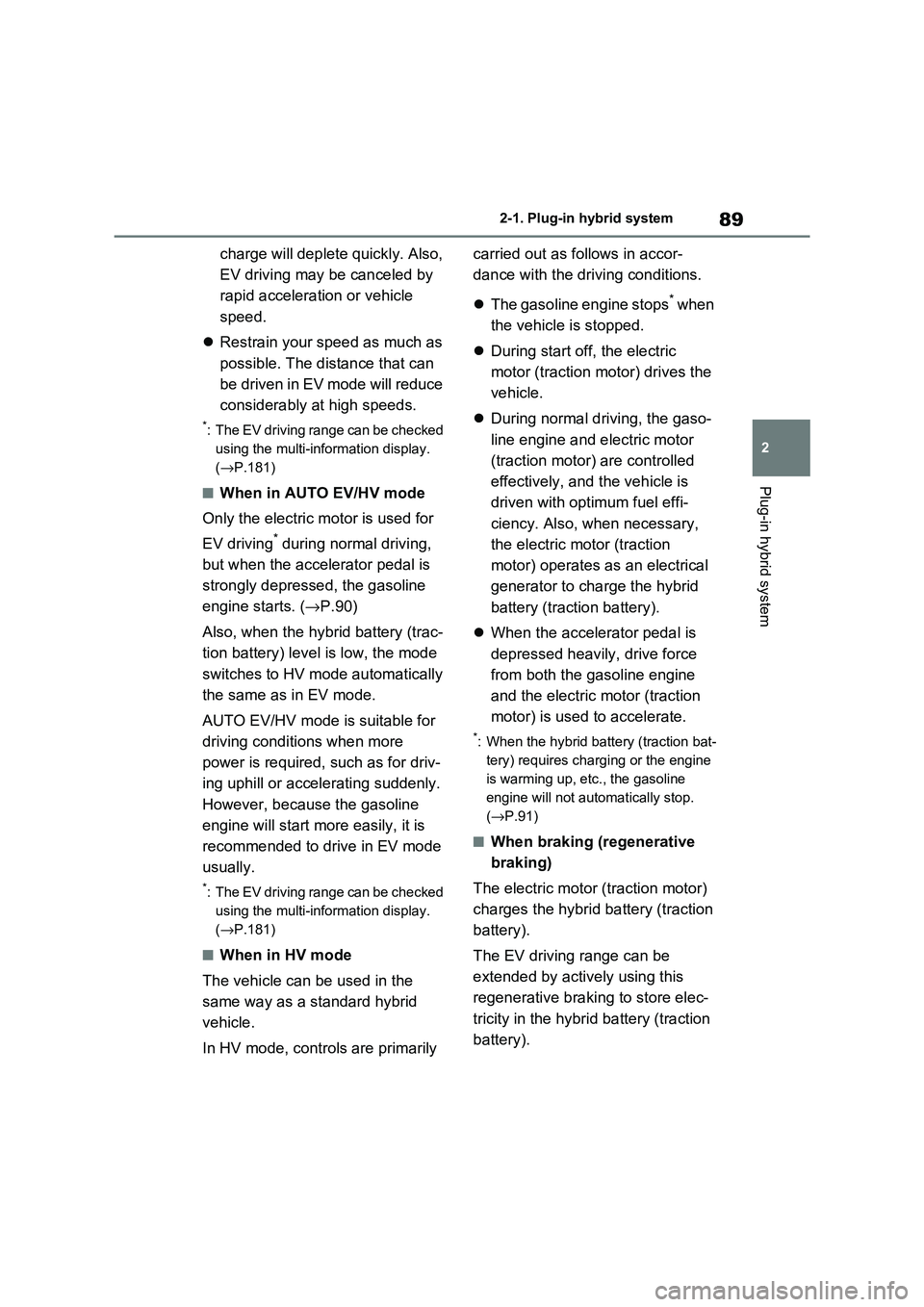
89
2
2-1. Plug-in hybrid system
Plug-in hybrid system
charge will deplete quickly. Also,
EV driving may be canceled by
rapid acceleration or vehicle
speed.
Restrain your speed as much as
possible. The distance that can
be driven in EV mode will reduce
considerably at high speeds.
*: The EV driving range can be checked
using the multi-information display.
( →P.181)
■When in AUTO EV/HV mode
Only the electric motor is used for
EV driving* during normal driving,
but when the accelerator pedal is
strongly depressed, the gasoline
engine starts. ( →P.90)
Also, when the hybrid battery (trac -
tion battery) level is low, the mode
switches to HV mode automatically
the same as in EV mode.
AUTO EV/HV mode i s suitable for
driving conditions when more
power is required, such as for driv -
ing uphill or accelerating suddenly.
However, because the gasoline
engine will start more easily, it is
recommended to drive in EV mode
usually.
*: The EV driving range can be checked
using the multi-information display.
( →P.181)
■When in HV mode
The vehicle can be used in the
same way as a standard hybrid
vehicle.
In HV mode, controls are primarily
carried out as follows in accor -
dance with the driving conditions.
The gasoline engine stops* when
the vehicle is stopped.
During start off, the electric
motor (traction motor) drives the
vehicle.
During normal driving, the gaso-
line engine and electric motor
(traction motor) are controlled
effectively, and the vehicle is
driven with optimum fuel effi -
ciency. Also, when necessary,
the electric motor (traction
motor) operates as an electrical
generator to charge the hybrid
battery (traction battery).
When the accelerator pedal is
depressed heavily, drive force
from both the gasoline engine
and the electric motor (traction
motor) is used to accelerate.
*: When the hybrid battery (traction bat -
tery) requires char ging or the engine
is warming up, etc., the gasoline
engine will not autom atically stop.
( →P.91)
■When braking (regenerative
braking)
The electric motor (traction motor)
charges the hybrid battery (traction
battery).
The EV driving range can be
extended by actively using this
regenerative braking to store elec -
tricity in the hybrid battery (traction
battery).
Page 92 of 666
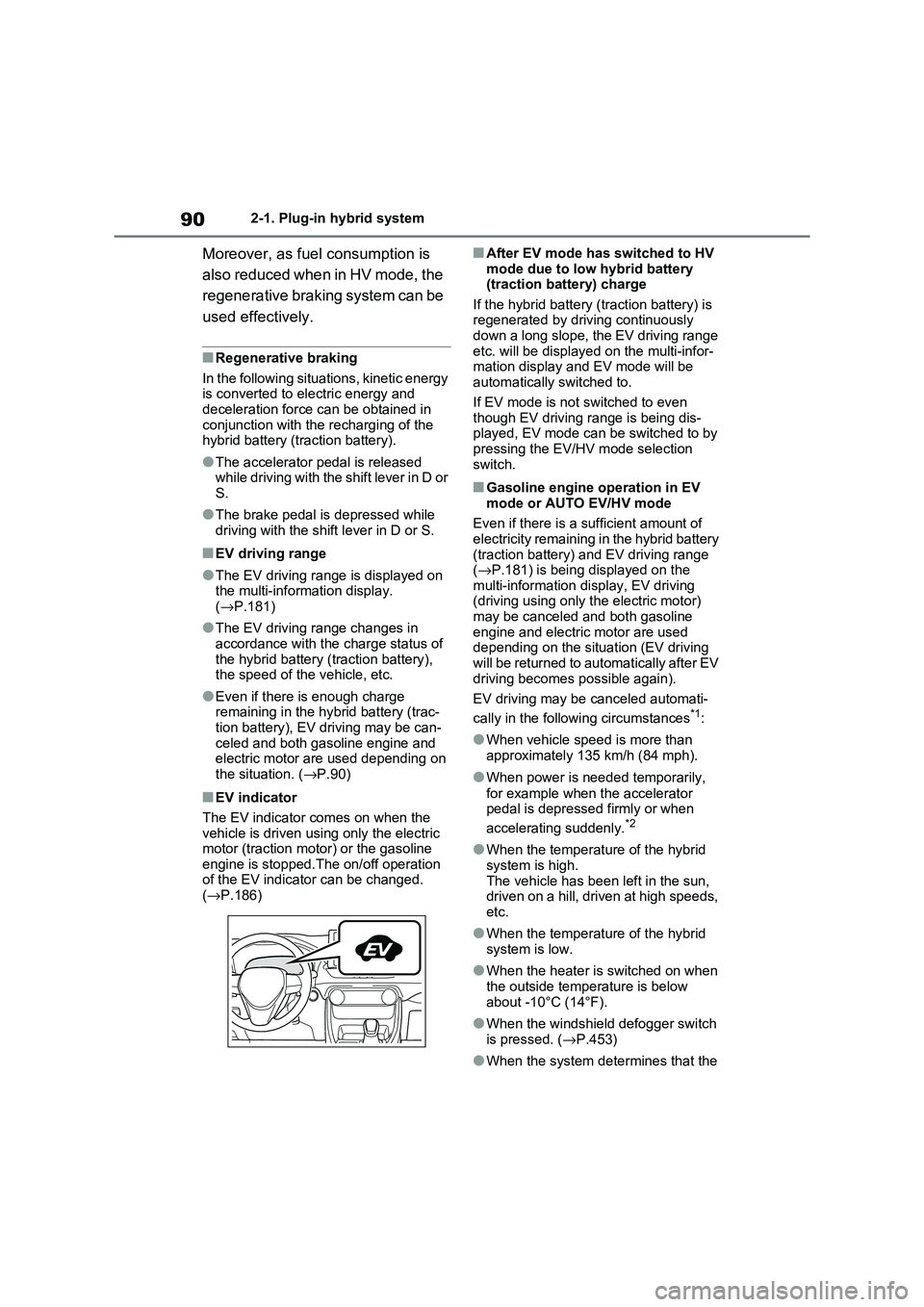
902-1. Plug-in hybrid system
Moreover, as fuel consumption is
also reduced when in HV mode, the
regenerative braking system can be
used effectively.
■Regenerative braking
In the following situations, kinetic energy is converted to electric energy and
deceleration force can be obtained in
conjunction with the recharging of the hybrid battery (traction battery).
●The accelerator pedal is released while driving with the shift lever in D or
S.
●The brake pedal is depressed while
driving with the shift lever in D or S.
■EV driving range
●The EV driving range is displayed on
the multi-information display.
( →P.181)
●The EV driving range changes in
accordance with the charge status of the hybrid battery ( traction battery),
the speed of the vehicle, etc.
●Even if there is enough charge
remaining in t he hybrid battery (trac-
tion battery), EV driving may be can- celed and both gasoline engine and
electric motor are used depending on
the situation. ( →P.90)
■EV indicator
The EV indicator comes on when the vehicle is driven usin g only the electric
motor (traction moto r) or the gasoline
engine is stopped.The on/off operation of the EV indicator can be changed.
( →P.186)
■After EV mode has switched to HV
mode due to low hybrid battery (traction battery) charge
If the hybrid battery ( traction battery) is
regenerated by driving continuously down a long slope, the EV driving range
etc. will be displaye d on the multi-infor-
mation display and EV mode will be automatically switched to.
If EV mode is not switched to even
though EV driving range is being dis - played, EV mode can be switched to by
pressing the EV/HV mode selection
switch.
■Gasoline engine operation in EV mode or AUTO EV/HV mode
Even if there is a su fficient amount of
electricity remaining in the hybrid battery (traction battery) and EV driving range
( →P.181) is being displayed on the
multi-information display, EV driving (driving using only the electric motor)
may be canceled and both gasoline
engine and electric motor are used depending on the situation (EV driving
will be returned to automatically after EV
driving becomes possible again).
EV driving may be canceled automati -
cally in the follo wing circumstances*1:
●When vehicle speed is more than
approximately 135 km/h (84 mph).
●When power is needed temporarily,
for example when the accelerator
pedal is depressed firmly or when
accelerating suddenly.*2
●When the temperatu re of the hybrid
system is high. The vehicle has been left in the sun,
driven on a hill, driven at high speeds,
etc.
●When the temperatu re of the hybrid
system is low.
●When the heater is switched on when
the outside temperature is below
about -10°C (14°F).
●When the windshield defogger switch
is pressed. ( →P.453)
●When the system determines that the
Page 93 of 666

91
2
2-1. Plug-in hybrid system
Plug-in hybrid system
gasoline engine needs to be started.*1: The gasoline engine may also oper -
ate in circumstances other than those
listed above, depending on condi -
tions.
*2: When driving in AUTO EV/HV mode.
Even in EV mode, the gasoline
engine may start, depending on the
condition of the hybrid battery (trac -
tion battery).
■If “Engine Started to Protect Sys -
tem EV driving unavailable” is dis - played on the mu lti-information
display
EV driving may be canceled in order to protect the hybr id system, etc.
In this case, perform driving with the
gasoline engine until EV driving will be returned to automatically.
■Conditions in which the gasoline
engine may not stop
The gasoline engine starts and stops automatically. Howev er, it may not stop
automatically in the following condi -
tions*:
●During gasoline engine warm-up
●During hybrid battery (traction battery)
charging
●When the temperature of the hybrid
battery (traction batt ery) is high or low
●When the windshield defogger switch
is pressed. ( →P.453)*: Depending on the circumstances, the
gasoline engine may also not stop
automatically in sit uations other than
those above.
■Sounds and vibrations specific to a
hybrid vehicle
There may be no engine sound or vibra - tion even though the vehicle is able to
move with the “READY” indicator is illu-
minated. For safety, apply the parking brake and make sure to shift the shift
lever to P when parked.
The following sounds o r vibrations may
occur when the hyb rid system is operat- ing and are not a malfunction.
●Motor sounds may be heard from the engine compartment.
●Sounds may be heard from the hybrid battery (traction battery) when the
hybrid system starts or stops.
●Relay operating sounds such as a
snap or soft clank will be emitted from
the hybrid battery ( traction battery), behind the rear seats, when the hybrid
system is started or stopped.
●Sounds from the hy brid system may
be heard when the back door is open.
●Sounds may be heard from the trans -
mission when the gasoline engine
starts or stops, when driving at low speeds, or during idling.
●Engine sounds may be heard when accelerating sharply.
●Sounds may be heard due to regener - ative braking when t he brake pedal is
depressed or as the accelerator pedal
is released.
●Vibration may be f elt when the gaso-
line engine starts or stops.
●Cooling fan sounds may be heard
from the air intake vent under the rear seat. ( →P.98)
●Sounds may be heard from near the hybrid battery (traction battery) in
accordance with th e operation of the
air conditioning syst em or “Battery Cooler” ( →P.129).
■Maintenance, repair, recycling, and
disposal
Contact any authoriz ed Toyota retailer
or Toyota authorized repairer, or any reliable repairer regarding mainte -
nance, repair, recycling and disposal.
Do not dispose of the vehicle yourself.
I n o r d e r t o m a k e E V m o d e o r A U T O
EV/HV mode available, charge the
Charging ( →P.105)
Page 95 of 666
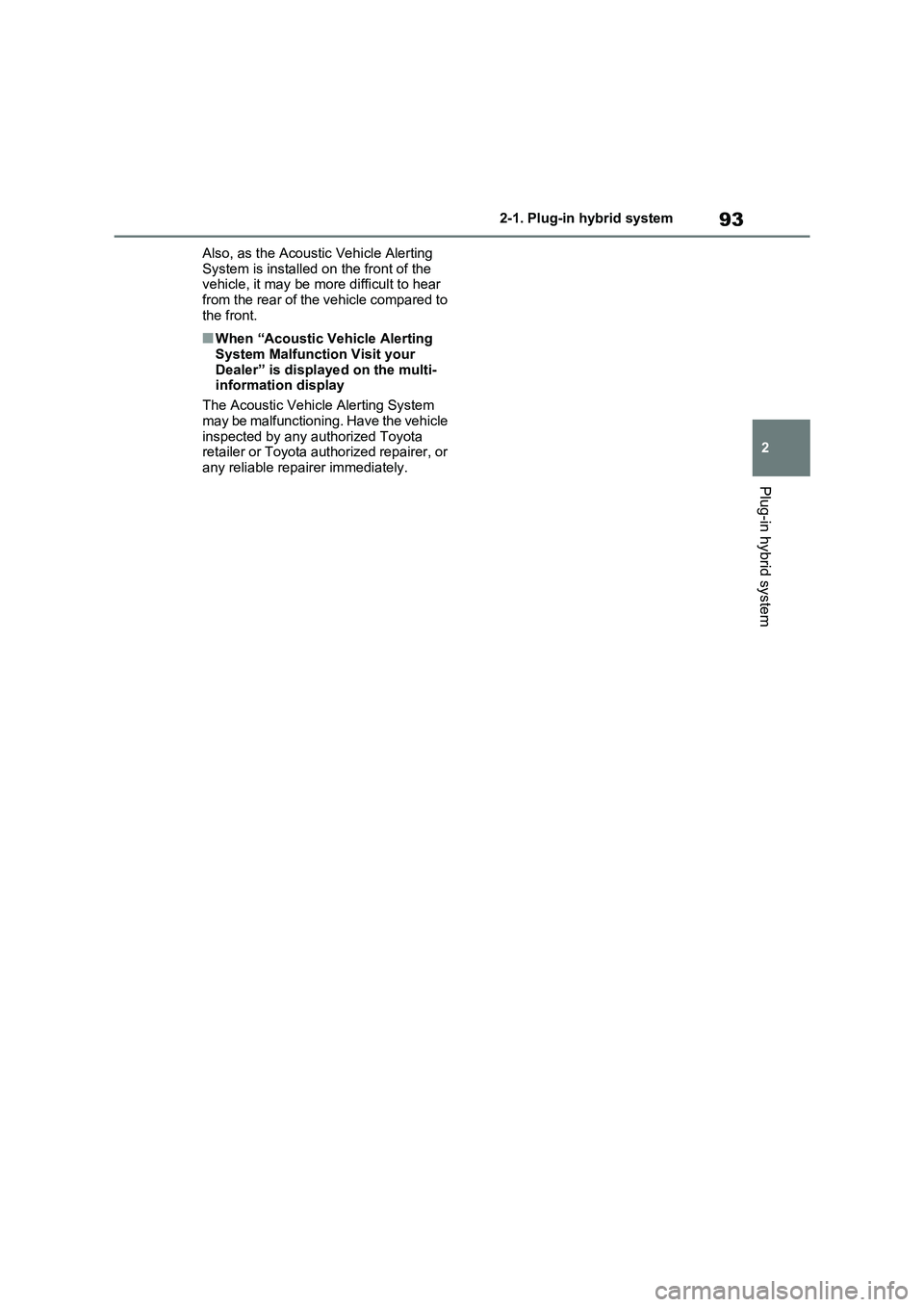
93
2
2-1. Plug-in hybrid system
Plug-in hybrid system
Also, as the Acoustic Vehicle Alerting
System is installed on the front of the vehicle, it may be more difficult to hear
from the rear of the vehicle compared to
the front.
■When “Acoustic Vehicle Alerting System Malfunction Visit your
Dealer” is displaye d on the multi-
information display
The Acoustic Vehicle Alerting System
may be malfunctioning. Have the vehicle
inspected by any authorized Toyota retailer or Toyota authorized repairer, or
any reliable repairer immediately.
Page 100 of 666
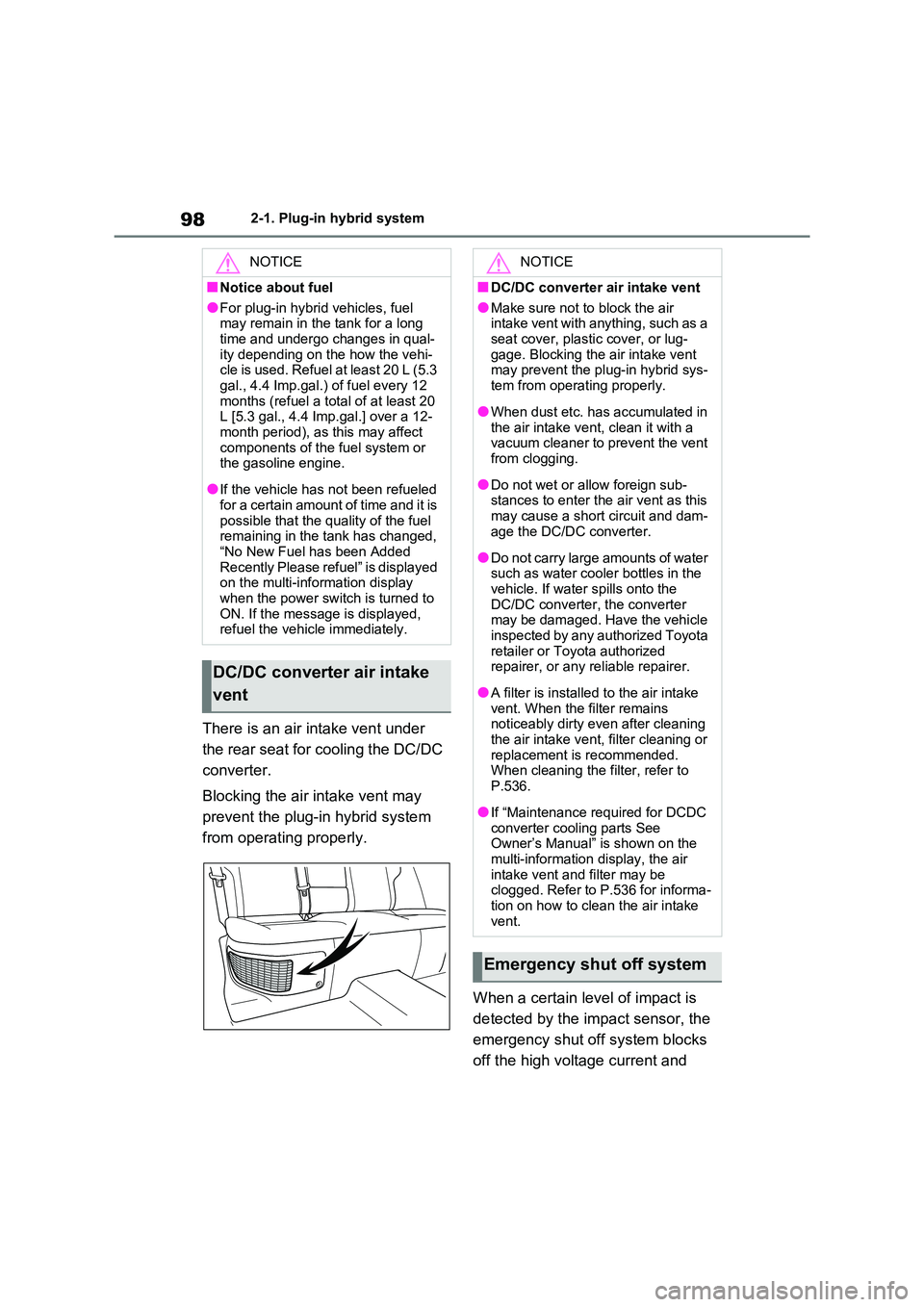
982-1. Plug-in hybrid system
There is an air intake vent under
the rear seat for cooling the DC/DC
converter.
Blocking the air intake vent may
prevent the plug-in hybrid system
from operating properly.
When a certain level of impact is
detected by the im pact sensor, the
emergency shut off system blocks
off the high voltage current and
NOTICE
■Notice about fuel
●For plug-in hybrid vehicles, fuel
may remain in the tank for a long time and undergo changes in qual -
ity depending on the how the vehi -
cle is used. Refuel at least 20 L (5.3 gal., 4.4 Imp.gal. ) of fuel every 12
months (refuel a tot al of at least 20
L [5.3 gal., 4.4 Imp.gal.] over a 12-
month period), as this may affect components of the fuel system or
the gasoline engine.
●If the vehicle has not been refueled
for a certain amount of time and it is
possible that the quality of the fuel remaining in the tank has changed,
“No New Fuel has been Added
Recently Please refuel” is displayed on the multi-information display
when the power switch is turned to
ON. If the message is displayed, refuel the vehicle immediately.
DC/DC converter air intake
vent
NOTICE
■DC/DC converter air intake vent
●Make sure not to block the air
intake vent with anything, such as a seat cover, plastic cover, or lug -
gage. Blocking the air intake vent
may prevent the plug-in hybrid sys - tem from operating properly.
●When dust etc. has accumulated in
the air intake ven t, clean it with a vacuum cleaner to prevent the vent
from clogging.
●Do not wet or a llow foreign sub-
stances to enter the air vent as this
may cause a shor t circuit and dam- age the DC/DC converter.
●Do not carry large amounts of water such as water cooler bottles in the
vehicle. If water spills onto the
DC/DC converter, the converter may be damaged. Have the vehicle
inspected by any authorized Toyota
retailer or Toyota authorized repairer, or any reliable repairer.
●A filter is installed to the air intake vent. When the filter remains
noticeably dirty even after cleaning
the air intake vent, filter cleaning or replacement is recommended.
When cleaning the filter, refer to
P.536.
●If “Maintenance required for DCDC
converter cooling parts See Owner’s Manual” is shown on the
multi-information display, the air
intake vent and filter may be clogged. Refer to P.536 for informa -
tion on how to clean the air intake
vent.
Emergency shut off system
Page 101 of 666
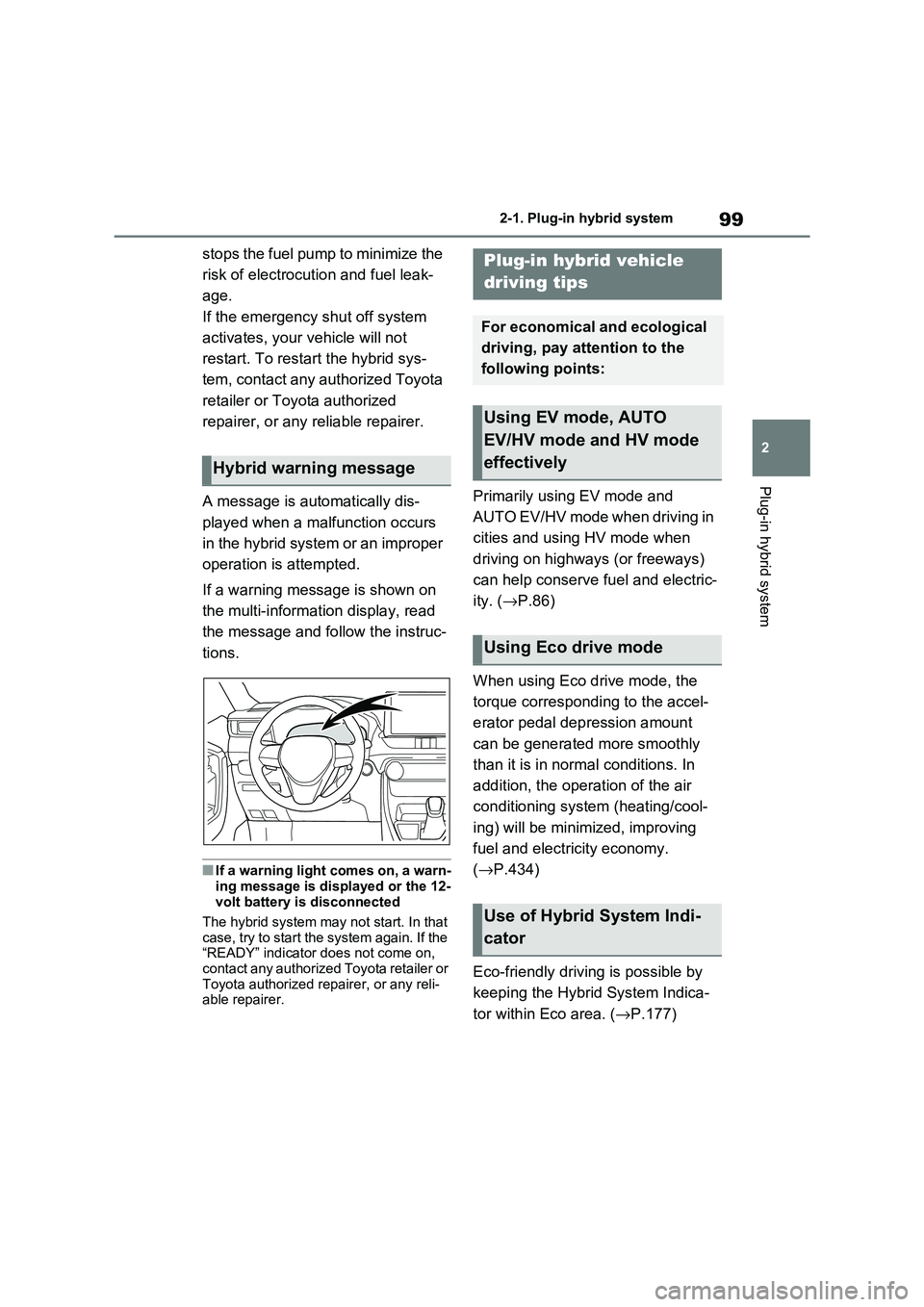
99
2
2-1. Plug-in hybrid system
Plug-in hybrid system
stops the fuel pump to minimize the
risk of electrocuti on and fuel leak-
age.
If the emergency shut off system
activates, your vehicle will not
restart. To restart the hybrid sys -
tem, contact any authorized Toyota
retailer or Toyota authorized
repairer, or any reliable repairer.
A message is automatically dis -
played when a malfunction occurs
in the hybrid system or an improper
operation is attempted.
If a warning message is shown on
the multi-informat ion display, read
the message and follow the instruc -
tions.
■If a warning light comes on, a warn - ing message is displayed or the 12-
volt battery is disconnected
The hybrid system may not start. In that
case, try to start the system again. If the “READY” indicator does not come on,
contact any authorized Toyota retailer or
Toyota authorized repairer, or any reli - able repairer.
Primarily using EV mode and
AUTO EV/HV mode when driving in
cities and using HV mode when
driving on highways (or freeways)
can help conserve fuel and electric -
ity. ( →P.86)
When using Eco drive mode, the
torque corresponding to the accel -
erator pedal depression amount
can be generated more smoothly
than it is in normal conditions. In
addition, the operation of the air
conditioning system (heating/cool -
ing) will be minim ized, improving
fuel and electricity economy.
( →P.434)
Eco-friendly driving is possible by
keeping the Hybrid System Indica -
tor within Eco area. ( →P.177)
Hybrid warning message
Plug-in hybrid vehicle
driving tips
For economical and ecological
driving, pay attention to the
following points:
Using EV mode, AUTO
EV/HV mode and HV mode
effectively
Using Eco drive mode
Use of Hybrid System Indi -
cator
Page 104 of 666

1022-1. Plug-in hybrid system
The value displayed on the SOC
(State of Charge) gauge ( →P.174)
is estimated from the following
information.
The amount of hybrid battery
(traction battery) charge cur -
rently remaining
The electricity consumption (the
estimated distan ce that EV driv-
ing is possible pe r unit of electri-
cal energy) based on the
recorded value
Past air conditioning system
electricity consumption amount
The electricity co nsumption varies
depending on how the vehicle is
driven. The vehicle automatically
records the electricity consumption
when being charged and uses the
electricity consumption for estimat -
ing the EV driving range. Therefore,
the EV driving ra nge displayed
when the hybrid battery (traction
battery) is fully charged may differ
from the previous EV driving range
depending on how the vehicle was
driven.
The EV driving r ange may change
significantly with each charging
until the electricity consumption
based on the recorded value is sta -
ble (for approximately the first
month or two). However, this does
not indicate a malfunction.
When the air conditioning system is
turned on, the EV driving range
(with using the air conditioning sys -
tem) is estimated based on the past
air conditioning electricity con -
sumption amount considering that
the electricity consumption may
become higher.
The distance that EV driving is pos -
sible varies signi ficantly depending
on how the vehicle is driven, road
conditions, the weather, the outside
temperature, usage conditions of
electrical components and the num -
ber of occupants.
The distance that EV driving is pos -
sible can be extended if the follow -
ing is performed:
EV driving range
The EV driving range displayed
on the multi-information dis -
play shows the reference dis -
tance that EV driving (driving
using only the electric motor)
is possible, and the actual dis-
tance that can be driven may
differ from that displayed.
Even if the EV dr iving range is
displayed, EV driving may be
canceled and both gasoline
engine and electric motor are
used depending on the situation.
( →P.90)
Displayed value
Tips for extending the EV
driving range
Page 105 of 666
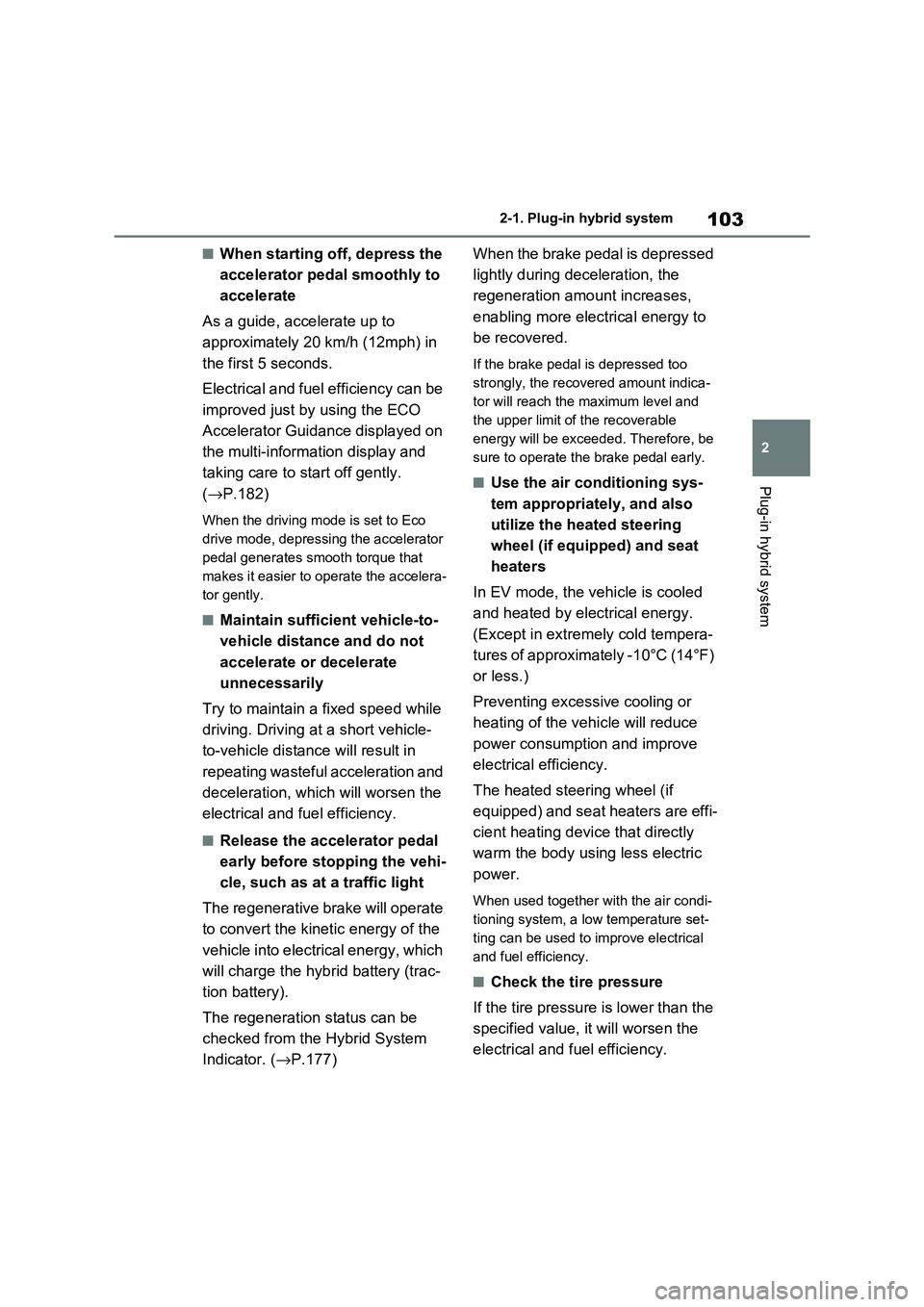
103
2
2-1. Plug-in hybrid system
Plug-in hybrid system
■When starting off, depress the
accelerator pedal smoothly to
accelerate
As a guide, acce lerate up to
approximately 20 km/h (12mph) in
the first 5 seconds.
Electrical and fuel efficiency can be
improved just by using the ECO
Accelerator Guidance displayed on
the multi-informat ion display and
taking care to start off gently.
( →P.182)
When the driving mode is set to Eco
drive mode, depressing the accelerator
pedal generates smooth torque that
makes it easier to operate the accelera -
tor gently.
■Maintain sufficient vehicle-to-
vehicle distance and do not
accelerate or decelerate
unnecessarily
Try to maintain a fixed speed while
driving. Driving at a short vehicle-
to-vehicle distance will result in
repeating wasteful acceleration and
deceleration, which will worsen the
electrical and fuel efficiency.
■Release the accelerator pedal
early before stopping the vehi -
cle, such as at a traffic light
The regenerative brake will operate
to convert the kinetic energy of the
vehicle into electrical energy, which
will charge the hyb rid battery (trac-
tion battery).
The regeneration status can be
checked from the Hybrid System
Indicator. ( →P.177)
When the brake pedal is depressed
lightly during deceleration, the
regeneration amount increases,
enabling more electrical energy to
be recovered.
If the brake pedal is depressed too
strongly, the recovered amount indica -
tor will reach the maximum level and
the upper limit of the recoverable
energy will be exceeded. Therefore, be
sure to operate the brake pedal early.
■Use the air co nditioning sys-
tem appropriately, and also
utilize the heated steering
wheel (if equipped) and seat
heaters
In EV mode, the vehicle is cooled
and heated by electrical energy.
(Except in extremely cold tempera -
tures of approximately -10°C (14°F)
or less.)
Preventing excessive cooling or
heating of the vehicle will reduce
power consumption and improve
electrical efficiency.
The heated steering wheel (if
equipped) and seat heaters are effi -
cient heating device that directly
warm the body using less electric
power.
When used together with the air condi -
tioning system, a low temperature set-
ting can be used to improve electrical
and fuel efficiency.
■Check the tire pressure
If the tire pressure is lower than the
specified value, i t will worsen the
electrical and fuel efficiency.
Page 106 of 666

1042-1. Plug-in hybrid system
A pressure level 50 kPa (0.5 kgf/cm2 or
bar, 7 psi) lower than the specified
value will cause a worsening of several
percentage points.
■When driving on highways,
use the EV/HV mode selection
switch to drive in HV mode
The power consumption will
increase significantly if the vehicle
is driven in EV mode on highways.
■Do not load unnecessary
objects in the vehicle
Driving with objects weighing 100
kg (220 lb.) in the vehicle will
worsen the electrical and fuel effi -
ciency by approximately 3%.
Air resistance also greatly affects
electrical and fuel efficiency.
Remove any exterior accessories
such as a roof luggage carrier when
they are not being used.
The running resistance of snow
tires is high and they will worsen
electrical and fuel efficiency.
Replace them with standard tires
as soon as they are no longer
needed.
■Know your vehicle’s electrical
and fuel efficiency
If you know your vehicle’s daily
electrical and fuel efficiency, you
will understa nd the benefits of Eco
drive.
Use the Power Consumption/Fuel
Economy, ECO Accelerator Guid -
ance/“Eco Score” and other data
displayed on the multi-information
display.
The following indicate that charging
has been carried out properly.
The charging indicator of the
charging port turns off
“Charging Complete” is dis-
played on the multi-information
display when a door is opened
with the power switch off
( →P.131)
Regardless of the type of power
source or whether the charging
schedule function is used, charging
is completed if the above can be
confirmed.
Charging-related messages: →P.160
Display when charging is
completed